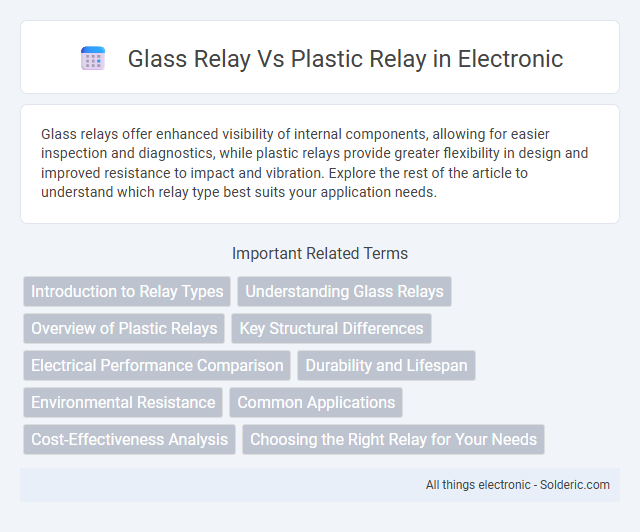Glass relays offer enhanced visibility of internal components, allowing for easier inspection and diagnostics, while plastic relays provide greater flexibility in design and improved resistance to impact and vibration. Explore the rest of the article to understand which relay type best suits your application needs.
Comparison Table
| Feature | Glass Relay | Plastic Relay |
|---|---|---|
| Material | Glass enclosure | Plastic enclosure |
| Visibility | Transparent, allows internal inspection | Opaque, internal parts not visible |
| Durability | Fragile, prone to breakage | Robust, impact-resistant |
| Weight | Lighter than plastic relays | Slightly heavier due to plastic casing |
| Cost | Generally higher due to glass manufacturing | Lower cost, economical for mass production |
| Insulation | Good electrical insulation | Excellent electrical insulation |
| Thermal Performance | Better heat dissipation | Moderate heat dissipation |
| Environmental Resistance | Less resistant to environmental impacts | Higher resistance to moisture and dust |
| Applications | Ideal for visible status monitoring | Preferred in harsh or industrial environments |
Introduction to Relay Types
Glass relays feature a transparent housing that allows visual inspection of internal components, enhancing reliability monitoring and early fault detection. Plastic relays, commonly used for their lightweight and cost-effectiveness, provide strong insulation and durability suitable for various industrial applications. Both relay types serve as essential electromagnetic switches, with glass relays favored in precise control circuits and plastic relays preferred in general-purpose switching.
Understanding Glass Relays
Glass relays offer superior protection by encasing their internal components in a sealed, transparent glass shell that prevents contamination and moisture damage, enhancing reliability and lifespan. Unlike plastic relays, which may be more prone to environmental wear and electromagnetic interference, glass relays maintain stable performance in critical applications such as automotive and industrial controls. Choosing glass relays for your devices ensures better durability, precise operation, and reduced maintenance costs.
Overview of Plastic Relays
Plastic relays offer lightweight construction and enhanced resistance to impact and moisture compared to glass relays, making them ideal for environments with mechanical stress or exposure to humidity. Their design typically includes durable polymer housings that provide electrical insulation and protect internal components, ensuring reliable performance in automotive, industrial, and consumer electronics applications. You can benefit from plastic relays' cost-effectiveness and adaptability without compromising on longevity or operational stability.
Key Structural Differences
Glass relays feature transparent, hermetically sealed casings that allow visual inspection of internal components, enhancing reliability and durability by protecting against moisture and contaminants. Plastic relays utilize opaque, molded housings that offer lightweight construction and cost efficiency but may lack the same level of environmental protection. Your choice between these relay types depends on application requirements for visibility, sealing, and material resilience.
Electrical Performance Comparison
Glass relays exhibit superior electrical performance due to their hermetically sealed design, which ensures minimal contact contamination and consistent conductivity over time. Plastic relays may suffer from moisture ingress and material degradation, leading to increased contact resistance and reduced reliability under high electrical loads. Your choice of relay should prioritize glass models for applications demanding high electrical stability and long-term durability.
Durability and Lifespan
Glass relays offer superior durability due to their rigid, non-corrosive enclosure, ensuring protection against environmental factors such as moisture, dust, and temperature fluctuations. Plastic relays, while cost-effective, tend to have shorter lifespans as their enclosures are more prone to wear, chemical degradation, and mechanical stress. Consequently, glass relays typically provide longer operational lifespans, reducing maintenance frequency and improving overall reliability in demanding applications.
Environmental Resistance
Glass relays offer superior environmental resistance due to their hermetically sealed design, which effectively protects internal components from moisture, dust, and corrosive agents. In contrast, plastic relays are more vulnerable to environmental factors such as high humidity and temperature fluctuations, leading to potential degradation over time. The robust glass enclosure ensures enhanced durability and reliability in harsh industrial settings where contamination and harsh conditions are prevalent.
Common Applications
Glass relays are commonly used in precision instrumentation and medical devices due to their excellent visibility and hermetic sealing, ensuring high reliability in sensitive environments. Plastic relays find frequent applications in automotive electronics, home appliances, and general industrial controls where cost-effectiveness and lightweight properties are prioritized. Your choice between glass and plastic relays should depend on the need for durability, environmental resistance, and application-specific performance requirements.
Cost-Effectiveness Analysis
Glass relays generally offer higher durability and superior insulation properties, making them a preferred choice in high-reliability applications despite their higher initial cost. Plastic relays provide a more cost-effective solution for mass production and low-stress environments due to lower material and manufacturing expenses. Evaluating total cost-effectiveness requires considering lifecycle costs, application demands, and failure rates, where plastic relays excel in budget-sensitive projects but glass relays reduce long-term maintenance expenses.
Choosing the Right Relay for Your Needs
Glass relays offer superior visibility and durability, making them ideal for applications requiring visual inspection and high reliability. Plastic relays provide lightweight and cost-effective solutions, suitable for general-purpose or less demanding environments. Consider your specific voltage, current ratings, and environmental conditions to choose the right relay that ensures optimal performance and longevity for your project.
Glass relay vs plastic relay Infographic

 solderic.com
solderic.com